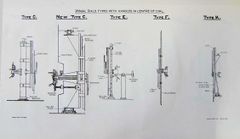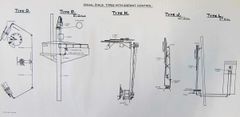Range Dial
A Range Dial (or "Concentration Dial") was a form of concentration signal by which ships could visually indicate their present gun range.
Mr. John A. Roberts responded to an initial inquiry into their nature by the following reply:
The Concentration Dials introduced in the Royal Navy in the latter part of the First World War were arranged like a clock with a short and long hand except that 12 o'clock was replaced by '0' and the remaining numbers (Roman I to IX) stopped at 9 o'clock. The hour hand indicated 1000 yard steps the minute hand 100 yard steps. There was also an arm at the back of the dial with a disc at the end which sat at the outer edge of the dial and could be aligned with number 0, II or III indicating 10000 yard steps. This arrangement covered ranges from 100 yards to 29,900 yards in 100 yard steps and was used to indicate the gun range in use. These dials were officially described in various ways including "range dial" and "clock dial" and probably quite a few others both official and unofficial. Many ships also had a second dial which was exactly like a clock (numbers I to XII, short and long hand) which was used for passing spotting information using a numeric code. The Type 31 was also employed to pass spotting and target indication information but could be used to pass other information as well (including range if necessary) — the method was (initially at least) left to the ships to employ whatever system worked best.
Other dial-based designs are described in Manual of Gunnery in H.M. Fleet, Volume III, 1920, along with a list of ships equipped with the various models.[1]
Type A Dial

These had two dials, each four feet in diameter. The hands were positioned by transmitting arms similar to those on a Semaphore Machine. The upper dial indicated range and the lower dial was used for various purposes by different squadrons. There were several variants on the design.
- Type A.I. (Inverted) had transmitters above the dials, on the same side of the tube
- Type A.R. (Reversed) had transmitters below the dials, on the opposite side of the tube
- Type A.I.R. had transmitters above the dials, on the opposite side of the tube.
- Type A.T. (Turret) was designed for use in a turret
By 1920, these were in use in a number of capital ships: the Revenge class, the Queen Elizabeth class, the King George V class, and Erin.[3]
Type B Dial

A single dial instrument similar to A, transmitting range only, and with similar sub-types, B.I., B.R. B.I.R. and B.T.
By 1920, these were in use in a number of capital ships and a few light cruisers: the Iron Duke class, the Indefatigable class, the Lion class, the Tiger, the Chatham class, the light cruisers Aurora, Galatea, Melbourne and Sydney.[5]
Type C Dial

This model was designed for use in light cruisers and had transmitters immediately behind their 4 foot dials, though a few ships had 9- or 10-foot dials. The modified "New Type C" was reworked to reduce weight.
By 1920, they were in use in the Iron Duke class, the Indefatigable class, Tiger, Ajax, Erin, the Emerald class, Diomede, Despatch, the Capetown class, Danae class, Ceres class, the Arethusa class, the Birmingham class, the Chatham class, Adelaide, Brisbane and Sydney.[7]
Type D Dial

These had 5 foot dials and could be worked remotely by use of chains to the transmitter handles.
By 1920, they were in use in the Orion class, the Lion class, and Hood.[9]
Type E Dial
These were similar to the original Type C, but had larger 7 foot dials.
As of 1920, however, no installations of them were recorded.[10]
Type F Dial
Could be fitted directly to a bulkhead with a 7 foot dial. By 1920, one of these were installed in each Revenge class battleship.
Type H Dial
Like Type D, afforded remote control by chains, but also able to pivot its 4 foot dials 40 degrees to either side. As of 1920, they were in use only in the Hawkins class.[11]
Type J Dial
A large 10 foot dial on a vertical standard. As of 1920, they were in use only in the Hawkins class.[12]
Type K Dial
Similar to Type C, but with a 10 foot dial hollowed by a 5 foot inner cut-out. As of 1920, however, no installations of them were recorded.[13]
Type L Dial
Similar to Types J and K, but with remote control by wire and chain and a shaft for training. As of 1920, they were in use in the Danae, Ceres, Capetown, and Caledon classes.[14]
Concentration Drum
See Also
Footnotes
- ↑ Manual of Gunnery in H.M. Fleet, Volume III, 1920, pp. 43-45.
- ↑ Manual of Gunnery in H.M. Fleet, Volume III, 1920, Plate 69.
- ↑ Manual of Gunnery in H.M. Fleet, Volume III, 1920, pp. 44.
- ↑ Manual of Gunnery in H.M. Fleet, Volume III, 1920, Plate 70.
- ↑ Manual of Gunnery in H.M. Fleet, Volume III, 1920, pp. 44-5.
- ↑ Manual of Gunnery in H.M. Fleet, Volume III, 1920, Plate 71.
- ↑ Manual of Gunnery in H.M. Fleet, Volume III, 1920, pp. 44-5.
- ↑ Manual of Gunnery in H.M. Fleet, Volume III, 1920, Plate 72.
- ↑ Manual of Gunnery in H.M. Fleet, Volume III, 1920, pp. 44-5.
- ↑ No mention in lists at Manual of Gunnery in H.M. Fleet, Volume III, 1920, pp. 44-5.
- ↑ Manual of Gunnery in H.M. Fleet, Volume III, 1920, pp. 44-5.
- ↑ Manual of Gunnery in H.M. Fleet, Volume III, 1920, pp. 44-5.
- ↑ No mention in lists at Manual of Gunnery in H.M. Fleet, Volume III, 1920, pp. 44-5.
- ↑ Manual of Gunnery (Volume III) for His Majesty's Fleet, 1920. pp. 44, 45.
Bibliography
- Schleihauf, William (April, 1998). "A Concentrated Effort: Royal Navy Gunnery Exercises at the End of the Great War." Warship International 35 (2): pp. 117–139.
- Manual of Gunnery in H.M. Fleet, Volume III, 1920.